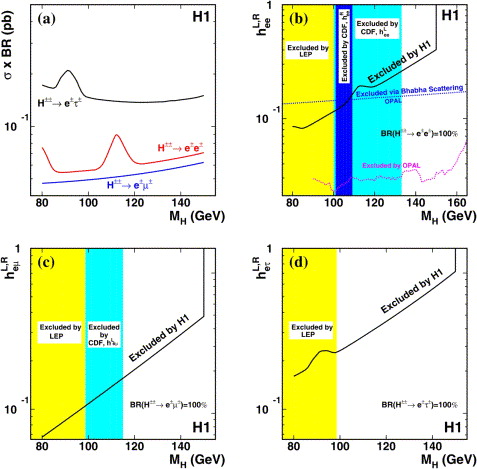
Search for doubly-charged Higgs boson production at HERA |
In a previous model independent multi-electron analysis, H1 observed six events with a di-electron mass above 100 GeV, a region where the Standard Model expectation is small. Out of the six events, only one is compatible with the signature of a doubly-charged Higgs boson. No electron-muon or electron-tau event is found in this mass domain. Therefore this analysis places new limits on the H北 production cross section, its mass and its Yukawa couplings hel to an electron-lepton pair.

Upper limits on the H北 production cross section times branching ratio are derived as a function of the H北 mass and are shown in Figure a. The best sensitivity is obtained for a H北 produced and decaying via heμ, with upper limits around 0.05 pb.
If the doubly-charged Higgs boson couples only to an electron pair (Figure b) this analysis rules out H北 masses below 138 GeV for a coupling hee of the electromagnetic strength, hee ~ 0.3. The result is compared to the bounds obtained from searches for H北 pair production at LEP and by the CDF experiment, and to both the indirect and direct limits obtained by the OPAL experiment, the latter being the most stringent. The OPAL experiment has also set similar stringent constraints on hee independently of the Higgs decay mode. These constraints also exclude a sizeable H北 production at HERA via hee followed by the H北 decay via hμμ or hττ, which is consistent with the non-observation of a resonance signal in the μμ and ττ final states in the present H1 data.
Assuming that the doubly-charged Higgs boson couples only to an electron-muon (electron-tau) pair, this analysis allows masses below 141 GeV (112 GeV) to be ruled out for heμ ~ 0.3 (heτ ~ 0.3), as shown in Figure c (Figure d). The H1 limits extend the excluded region in the electron-muon and electron-tau channels to masses that are beyond those reached in previous searches for pair production at LEP and the Tevatron.
Last Update 19.01.2007 Bob Olivier